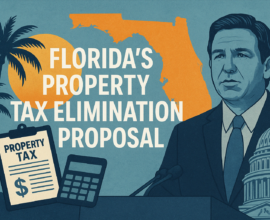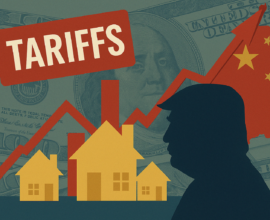Will Ohio Foreclosures Flood the Market in 2023 because of the Interest Rate Hikes?
Could heightened mortgage interest rates cause a surge of foreclosures throughout Ohio in 2023? Higher interest rates negatively impact affordability, making borrowers more vulnerable to significant financial problems like foreclosure. However, many other variables are also critical factors that influence a housing market.
For example, the number of residential homes in any particular metro area is finite, meaning that supply and demand remain very influential in a regional housing market. When demand for homes is high, home prices will also rise. Here, as with when interest rates surge, borrowers face affordability problems.
Some of the other key factors include the status of local new-home construction activity, inflation levels, and the local job (employment) market.
The January 2023 forecast from the Mortgage Bankers Association projects that rates will decline to approximately 5.2% by the end of the year.
What is the Current Status of Mortgage Rates?
Many variables in the housing market are drastically different between states or regions—such as home values. In 2022, the average home price in Ohio was approximately $213,360, which is vastly different from Colorado ($604,911), Massachusetts ($611,819), or California ($816,804).
While current mortgage rates might vary slightly between lenders or geographic locations, rates for conventional mortgages are surprisingly similar across the country. State-to-state variances in rates rarely exceed a fraction of 1%, meaning that the national consensus rates will suffice despite focusing specifically on Ohio’s market.
| Mortgage Interest: 30-Year Fixed Rate | September 2022 | October 2022 | November 2022 | December 2022 | January 2023 |
| Bankrate | 6.28 | 6.89 | 7.24 | 6.52 | 6.36 |
| Freddie Mac | 6.02 | 6.94 | 6.58 | 6.27 | 6.15 |
The large upsurge in interest rates began during the spring and summer months of 2022 and reached a peak in the fall of 2022. This spike in rates resulted from the Federal Reserve’s efforts toward curtailing record-high inflation. As this table indicates, rates appear to be stabilizing in 2023 — and many experts seem optimistic. The January 2023 forecast from the Mortgage Bankers Association projects that rates will decline to approximately 5.2% by the end of the year.
Traditionally, at any given point, roughly 1% of U.S. mortgages are in some phase of the foreclosure process.
How COVID Makes the 2020 and 2021 Foreclosure Data Useless
The widespread “foreclosure moratorium” implemented in 2020 amid the COVID-19 pandemic largely renders the foreclosure data through the end of 2021 unreliable at best. Many mortgages entered forbearance, meaning the payments were temporarily suspended or differed.
Traditionally, at any given point, roughly 1% of U.S. mortgages are in some phase of the foreclosure process. Comparing the 2022 data back to 2019 (pre-pandemic) data, filed foreclosures decreased by approximately 34% in 2022.
Ohio’s High Foreclosure Rate in 2022 Compared to Other U.S. States
Most major housing markets in Ohio demonstrated stability in 2022 with statewide home values up 4% and favorable conditions for real estate investors. However, regardless of how you analyze the 2022 data, Ohio ranked among the states with the most foreclosures. Consider the following facts:
- Ohio had the fourth-highest foreclosure rate among all U.S. states in 2022 (0.38%).
- Ohio had the fifth most foreclosure starts among U.S. states in 2002 (13,469).
- Among U.S. cities with a population of 200,000+, Cleveland had the highest foreclosure rate (0.70% of housing units with a foreclosure filing).
- In December 2022, around one of every 3,027 homes in Ohio was in foreclosure.
Despite Ohio’s high foreclosure rate in comparison to other states, it remains well below 1%, which is a national historic norm.
Data indicates that more than 60% of Americans are essentially struggling “paycheck-to-paycheck” without room for unforeseen expenses.
Why Foreclosures Happen
Each year, roughly five million home foreclosures or rental evictions occur nationwide. Many Americans find themselves in financial positions without much leeway, as outgoing expenses consume the majority of their income each month. The U.S. Census Bureau considers households that spend more than 30% of their income on housing as “burdened” and susceptible to financial distress. Experian recommends that consumers keep their housing expenses below 28% of their gross income.
Data indicates that more than 60% of Americans are essentially struggling “paycheck-to-paycheck” without room for unforeseen expenses. Under these circumstances, an unexpected loss of employment, serious medical problems such as injury or illness, or a divorce might trigger a spiral that ends in foreclosure.
Another widespread problem in Ohio and much of the U.S. that is creating housing instability is a limited supply — specifically a lack of affordable housing. The Columbus, Ohio, market is experiencing these concerns.
Home prices in the Columbus market continue to rise, and the supply of available homes is insufficient. In 2022, the combination of rising prices and interest rates caused a surge equating to $500 per month for those seeking a mortgage.
Fixed Rate vs Adjustable-Rate Mortgages
The most common mortgage in the U.S. has a 30-year term with a fixed interest rate. Adjustable-rate mortgages (ARM) are an alternative that often features lower introductory rates, but the rates will fluctuate over the years in response to certain market conditions. With the currently exorbitant fixed interest rates, some experts suggest that we will witness an ARM resurgence!
During the pandemic, only about 5% of mortgages were ARMs. In the middle of 2022, approximately 10% of mortgage applications were ARMs, and this rose to 12% by the end of the year. In many cases, borrowers with an ARM will experience financial stress stemming from a rate increase and the resultant higher mortgage payment, which could trigger financial problems that ultimately result in foreclosure.
Today, mortgage servicers must provide borrowers with reasonable advanced notice of any upcoming rate increases. While borrowers with ARMs have a slightly higher likelihood of foreclosure, the current 10% market share should decrease as interest rates decline, making their impact on foreclosures rather negligible.
Delinquent Mortgage Activity in Ohio Housing Markets
One of the more reliable indicators of future foreclosure activity is mortgage delinquency rates. In Ohio, lenders will generally initiate foreclosure proceedings once a borrower is delinquent or deficient for 120 days.
Nasdaq recently included four Ohio cities as among those with high mortgage delinquency rates — a potential indicator of ensuing problems.
| Ohio Cities | % Of Mortgages Delinquent: 30 to 89 Days | % Of Mortgages Delinquent: Over 90 Days |
| Cleveland | 0.9 | 0.6 |
| Akron | 0.8 | 0.7 |
| Toledo | 1.0 | 0.7 |
| Dayton | 0.9 | 0.7 |
Source: NASDAQ
Today, mortgage servicers must maintain some designated staff members available for communicating with delinquent borrowers and proposing alternatives that could avoid foreclosure.
Is a Full-Blown Foreclosure “Crisis” Unlikely?
The term foreclosure among middle-aged and older Americans will likely trigger thoughts of the Great Recession that devastated the U.S. economy for several years after beginning in late 2007. Americans lost an estimated 3.7 to 4.1 million homes to foreclosure during these dark days.
In response to this crisis, federal agencies and consumer advocacy organizations implemented regulations restricting much of the risky and deceptive activity that was rampant — particularly in the subprime mortgage market.
The Consumer Financial Protection Bureau (CFPB) explains that the measures currently in place should prevent borrowers from experiencing “surprises” or “runarounds” that often occurred involving those servicing mortgages in the past. Today, mortgage servicers must maintain some designated staff members available for communicating with delinquent borrowers and proposing alternatives that could avoid foreclosure. For example, loan modifications, deferred payments, and other mitigation efforts often help successfully prevent foreclosure.
Statewide, Ohio’s housing sales are expected to remain cool compared to the heights of 2021, with interest rates still gradually declining.
Positive Signs in the Home Mortgage Market
Equity
Overall, the average borrower in America has substantially more equity in their home today than in the past. Homeowners who achieve even small amounts of equity in their homes are much less likely to endure foreclosure, as more of those facing a financial calamity can sell their homes for an amount that equals or exceeds their mortgage balance.
Many existing homeowners have ultra-low mortgage rates
In September 2022, Redfin reported that 85% of existing homeowners have mortgages with rates below 6%. Nearly 70% of existing homeowners have a current mortgage rate of only 4%.
Ohio’s Foreclosure Outlook 2023
Statewide, Ohio’s housing sales are expected to remain cool compared to the heights of 2021, with interest rates still gradually declining.
In terms of foreclosures, mortgage delinquencies exceeding 90 days in Ohio are in the 0.4 to 0.7 range. While many of those in the late stages of delinquency will soon face foreclosure — some will not. The result is that the statewide foreclosure rate will likely hover around 0.5, which is still 50% below the 1% traditional average.
A more glaring short to long-term concern in Ohio is a shortage of housing inventory (especially for low-to-middle earners). Among real estate investors, Ohio remains viable, particularly if interest rates return to more reasonable levels.








